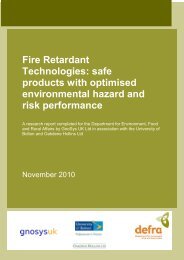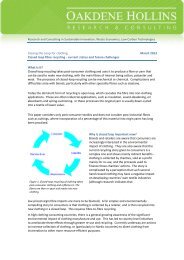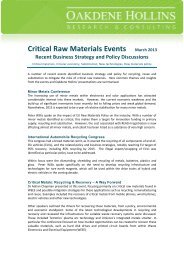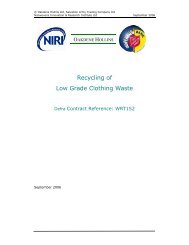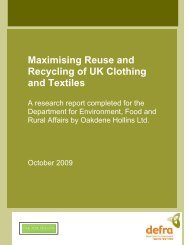Procurement and Supply Chain - Oakdene Hollins
Procurement and Supply Chain - Oakdene Hollins
Procurement and Supply Chain - Oakdene Hollins
Create successful ePaper yourself
Turn your PDF publications into a flip-book with our unique Google optimized e-Paper software.
WR1403: Business Waste Prevention Evidence Review<br />
L2m4-3: <strong>Procurement</strong> & <strong>Supply</strong> <strong>Chain</strong><br />
4 Behavioural Aspects<br />
4.1 Motivators<br />
Despite growing evidence that consumers bear in mind environmental <strong>and</strong> particularly ethical factors<br />
when purchasing products for personal or family use (77), their behaviour in the workplace may be<br />
different. A 2006 survey on 1,000 employees across UK public <strong>and</strong> private sector organisations indicated<br />
that employees tended to behave in less ‘environmentally friendly’ ways in the workplace than at home.<br />
It found that despite having a clear underst<strong>and</strong>ing of what steps they need to adopt, employees look<br />
towards their employer to lead by example when it comes to being environmentally responsible (78).<br />
Similarly, a 2009 survey found that while 87% of respondents thought it was ‘everyone’s’ responsibility to<br />
be resource efficient at work, a significant proportion failed to perform waste prevention tasks at work<br />
which they might do at home (79).<br />
Evidence suggests that environmental concerns alone are unlikely to drive voluntary sustainable<br />
procurement behaviour by businesses. For example, a 2009 study found that CSR pressures were “not a<br />
major driver in encouraging remanufacture <strong>and</strong> remanufactured RDCs [refrigerated display cabinets]”, in<br />
part due to the problems with quantifying the environmental benefits (66). The adoption of sustainable<br />
procurement by a company seems instead to be motivated by the following factors:<br />
Cost<br />
The opportunity to reduce costs <strong>and</strong> increase competitiveness seems to be a driver of waste prevention<br />
in the supply chain. For example, in evidence to the 2007-8 Session of the House of Lords Science <strong>and</strong><br />
Technology Committee on Waste Reduction, a senior manager at Nissan revealed that the motor<br />
manufacturer ‘issues green purchasing guidelines to its suppliers <strong>and</strong> asks them to “take responsibility for<br />
their own waste <strong>and</strong> recycling … *We+ dem<strong>and</strong> cost reductions <strong>and</strong> efficiency improvements year on year<br />
on year. We know inside our own plant that when you dem<strong>and</strong> those kinds of cost reductions it makes<br />
people avoid waste …”’ (31 p. 80). Cost-saving is also a reason businesses choose remanufactured<br />
products such as refrigerated display cabinets (66) toner cartridges (68 p. 5), furniture (80). Other<br />
motivations for buying remanufactured goods include “the ability to perform cost-effective energy<br />
upgrades <strong>and</strong> to enable specified customisations to enhance the retail br<strong>and</strong>” (66). The example<br />
discussed in Section 3.2 of a motor insurance company (Aviva) asking its supplier to switch to less<br />
wasteful repair techniques was motivated by a need to cut costs (34).<br />
Company performance<br />
Closely allied with cost-reduction is the less tangible motivator of “improved company performance”. A<br />
2009 report from the Engineering Employers’ Federation (EEF) cited “an improved public image <strong>and</strong><br />
competitive advantage via innovation…” as potential drivers. (2 p. 25) Similarly, Successful business <strong>and</strong><br />
procurement, the 2010 review published by SDRN, concluded “with a moderate degree of certainty” that<br />
strategic purchasing <strong>and</strong> supply chain management (SCM) had “a positive impact on a firm’s<br />
performance”. The report stresses that these activities “go beyond traditional cost-reduction [<strong>and</strong>] are<br />
aligned with internal integration <strong>and</strong> a firm’s business strategy, <strong>and</strong> entail buyers being aware of the<br />
strategic direction of the firm.” (5 p. 7)<br />
Regulation<br />
The 2010 SDRN report cites regulation as “‘an important aspect of encouraging sustainable SCM in firms”<br />
(5 p. 9) <strong>and</strong> recommends that more needs to be done to create a regulatory environment that<br />
encourages, enables or requires the private sector to adopt sustainable procurement practices. But<br />
evidence that regulations have motivated procurement in a way that results in waste prevention is<br />
28 For Defra



